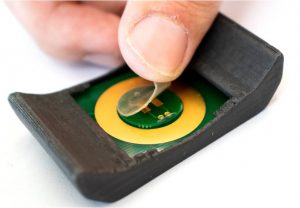Engineers at University of California Los Angeles have found a way to create a stretchable adhesive skin chemistry sensor without serpentine electrical conductors.
Instead, they persuaded the liquid sweat to move sideways through the film – maintaining stretchability – while electrical connections are made through the thickness of the sensor to a rigid electrode array at the rear – in this case on the back of a custom smart watch
The various layers and voids in the sensor are engineered to isolate the electrical paths from movement, reducing ‘motion artefacts’ in the signals.
Instead, the UCLA engineers use this as the rear layer to connect the sensor, which is nominally disposable, to the fixed permanent electrode array at the back of the watch.
On the other side of the tape are deposited a regular array of square gold electrodes.
Each of these electrodes, separately electrically connected to the electronics behind through the tape, has a different coating – either enzymes that are affected by the chemical to be sensed, or chemicals that make reference electrodes for the electro-chemistry involved.
At this point dear reader, I apologise. As there should have been a diagram further up in this article to help make all of this clear. But working from a kitchen table, without the full resources of Electronics Weekly Towers, means there adding one will take at least another day.
Deep breath….
Lastly there is an elastomeric sticky-back layer that bonds the whole thing to the skin. This layer has chambers cut in corresponding to the electrode pattern, and these chambers are connected by narrow microfluidic channels that cause sweat to flow from one chamber to the next in the appropriate order.
As well as providing a volume of liquid in which reactions an occur, it is these chambers that block skin-induced mechanical movement from getting to the electrodes and the conductive paths behind them.
 The complete assembly resembles a thin sheet of jelly (see photo) that can be aligned and stuck to the back of the watch, and then used to stick the watch to the skin.
The complete assembly resembles a thin sheet of jelly (see photo) that can be aligned and stuck to the back of the watch, and then used to stick the watch to the skin.
“By making our sensors on a double-sided adhesive and vertically conductive film, we eliminated the need for the external connectors,” said researcher Yichao Zhaoao. “In this way, not only have we made it easier to integrate sensors with consumer electronics, but we’ve also eliminated the effect of a user’s motion that can interfere with the chemical data collection.”
In the proof-of-concept, the enzyme layers were designed to react to glucose, which indicates body metabolism levels, and nutrients such as choline.
The system worked with someone doing nothing, someone doing office work and someone boxing, and stayed stuck for a whole day without a wrist strap.
UCLA has applied for a patent on the technology.
The work is covered in the paper ‘A wearable freestanding electrochemical sensing system‘, published in Science Advances and available in full free-of-charge. I found it dificulat to understand the structure of the sensor without reading the detailed Supplementary information
A New Approach To Skin Chemistry Sensing
Source: electronicsweekly










